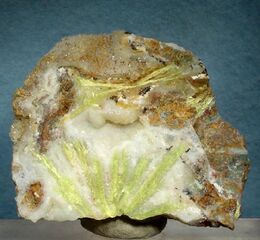Chemistry:Carpathite
| Carpathite | |
|---|---|
 Carpathite from New Idria District, California USA | |
| General | |
| Category | Organic mineral |
| Formula (repeating unit) | C24H12 |
| Strunz classification | 10.BA.30 |
| Crystal system | Monoclinic |
| Crystal class | Prismatic (2/m) (same H-M symbol) |
| Space group | P21/c, P21/n[1] |
| Unit cell | a = 1625 pm, b = 463.8 pm, c = 1042 pm; β = 111°10';[1] Z = 2 |
| Identification | |
| Color | Yellow, yellowish brown on exposure |
| Crystal habit | Acicular to thin tabular in bladed groups and fibrous radiating aggregates |
| Cleavage | Perfect on [001], [100] and [201] |
| Fracture | Splintery |
| Tenacity | Flexible, nearly plastic |
| Mohs scale hardness | 1.5 |
| |re|er}} | Vitreous - adamantine |
| Streak | Yellow white |
| Diaphaneity | Transparent |
| Specific gravity | 1.35 |
| Optical properties | Biaxial (+/-) |
| Refractive index | nα = 1.760 - 1.780 nβ = 1.977 - 1.982 nγ = 2.050 - 2.150 |
| Birefringence | δ = 0.290 - 0.370 |
| Melting point | 432.8 °C [2] |
| Other characteristics | Fluorescent - electric blue to blue-green |
| References | [3][4][5][6] |
Carpathite is a very rare hydrocarbon mineral, consisting of exceptionally pure coronene (C24H12), a polycyclic aromatic hydrocarbon.[8][9] The name has been spelled karpatite[2] and the mineral was improperly renamed pendletonite.[1]
Discovery
The mineral was first described in 1955 for an occurrence in Transcarpathian Oblast, Ukraine . It was named for the Carpathian Mountains.[4]
In 1967, unaware of the earlier description, Joseph Murdoch analyzed and described a specimen from the Picacho Peak area of San Benito County, California and named it "pendletonite".[1]
Structure
Carpathite has the same crystal structure of pure coronene. The molecules are planar and lie in two sets with roughly perpendicular orientations. Molecules in the same set are parallel and partially offset, with planes 0.3463 nm apart. That is slightly larger than the inter-layer distance of graphite layers (0.335 nm), and much larger than the C-C bond lengths within the molecule (about 0.14 nm). This "corrugated layer" structure is highly resistant to intercalation, which apparently explains the purity of the mineral.[2]
Occurrence
In the Ukraine discovery location, carpathite occurs at the contact zone of a diorite intrusive into argillite within cavities, and is associated with idrialite, amorphous organic material, calcite, barite, quartz, cinnabar, and metacinnabar.[6] It has also been reported in the Presov Region of the Slovak Republic[4] and in the Kamchatka Oblast in Russia.[4]
In the California location, it occurs in centimeter-size veins, associated (and somewhat contemporaneous) with quartz and cinnabar, in a silicified matrix. Crystals are up to 10 × 1 × 1 mm.[1] Carbon isotope ratios and the morphology of the deposit indicate that the coronene was produced from organic matter in oceanic sediment, thermally decomposed, purified through hydrothermal transportation and chemical reactions, and deposition below 250 °C, after the other minerals in the intrusion.[2]
References
- ↑ 1.0 1.1 1.2 1.3 1.4 Joseph Murdoch and Theodore A. Geissman (1967): "Pendletonite, a new hydrocarbon mineral from California". American Mineralogist, volume 52, issues 5-6, pages 611–616. Quote: "Mr. Forrest Cureton, who sent in the specimens, has asked that the mineral, if it turned out to be new, be named after Mr. Norman H. Pendleton, of Santa Cruz, California, who was apparently the first to suspect that the crystals were not valentinite"
- ↑ 2.0 2.1 2.2 2.3 Takuya Echigo, Mitsuyoshi Kimata, and Teruyuki Maruoka (2007): "Crystal-chemical and carbon-isotopic characteristics of karpatite (C24H12) from the Picacho Peak Area, San Benito County, California: Evidences for the hydrothermal formation". American Mineralogist, volume 92, issues 8-9, pages 1262–1269. doi:10.2138/am.2007.2509
- ↑ Mineralienatlas
- ↑ 4.0 4.1 4.2 4.3 Mindat with location data
- ↑ Webmineral data
- ↑ 6.0 6.1 Handbook of Mineralogy
- ↑ Warr, L.N. (2021). "IMA–CNMNC approved mineral symbols". Mineralogical Magazine 85 (3): 291–320. doi:10.1180/mgm.2021.43. Bibcode: 2021MinM...85..291W.
- ↑ Max Blumer (1975): "Curtisite, idrialite and pendletonite, polycyclic aromatic hydrocarbon minerals: Their composition and origin" Chemical Geology, volume 16, issue 4, pages 245-256. doi:10.1016/0009-2541(75)90064-9
- ↑ Stephen A. Wise, Robert M. Campbell, W. Raymond West, Milton L. Lee, Keith D. Bartle (1986): "Characterization of polycyclic aromatic hydrocarbon minerals curtisite, idrialite and pendletonite using high-performance liquid chromatography, gas chromatography, mass spectrometry and nuclear magnetic resonance spectroscopy". Chemical Geology, volume 54, issues 3–4, pages 339-357. doi:10.1016/0009-2541(86)90148-8
 |

